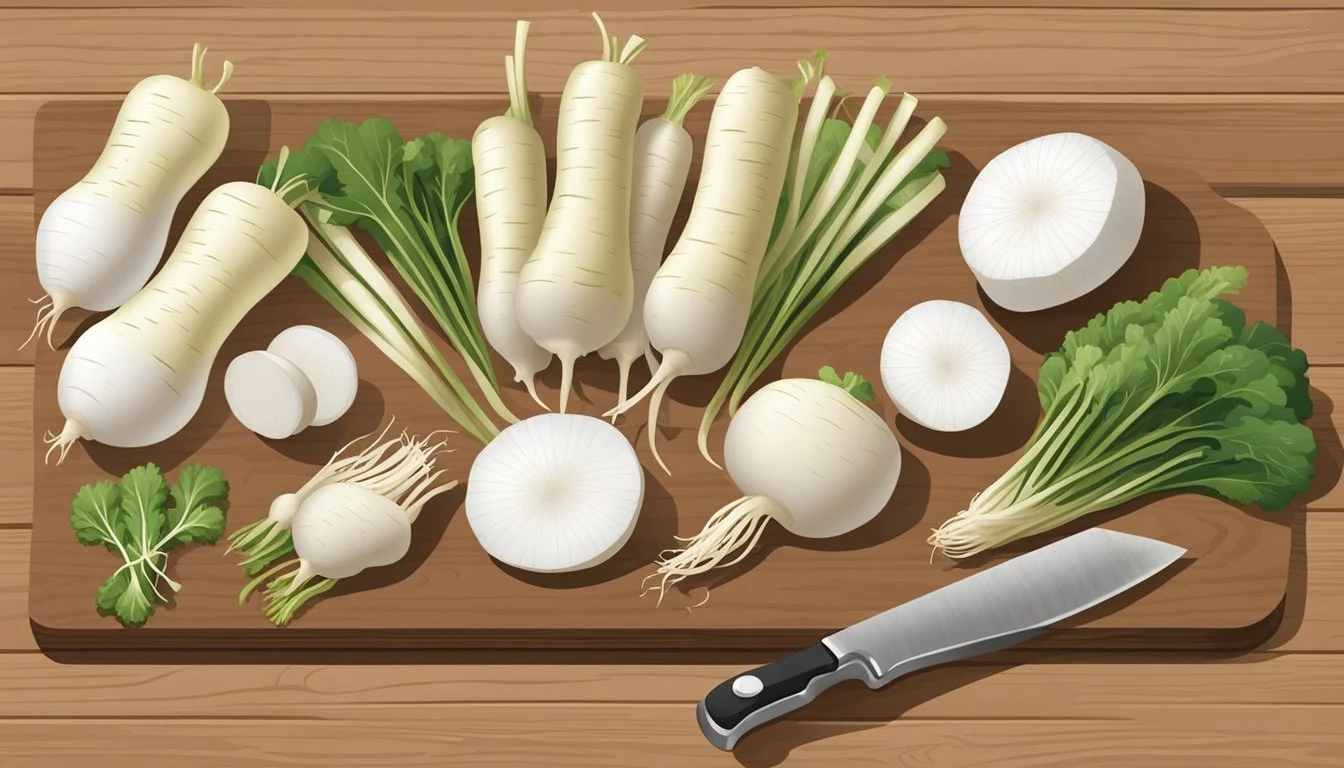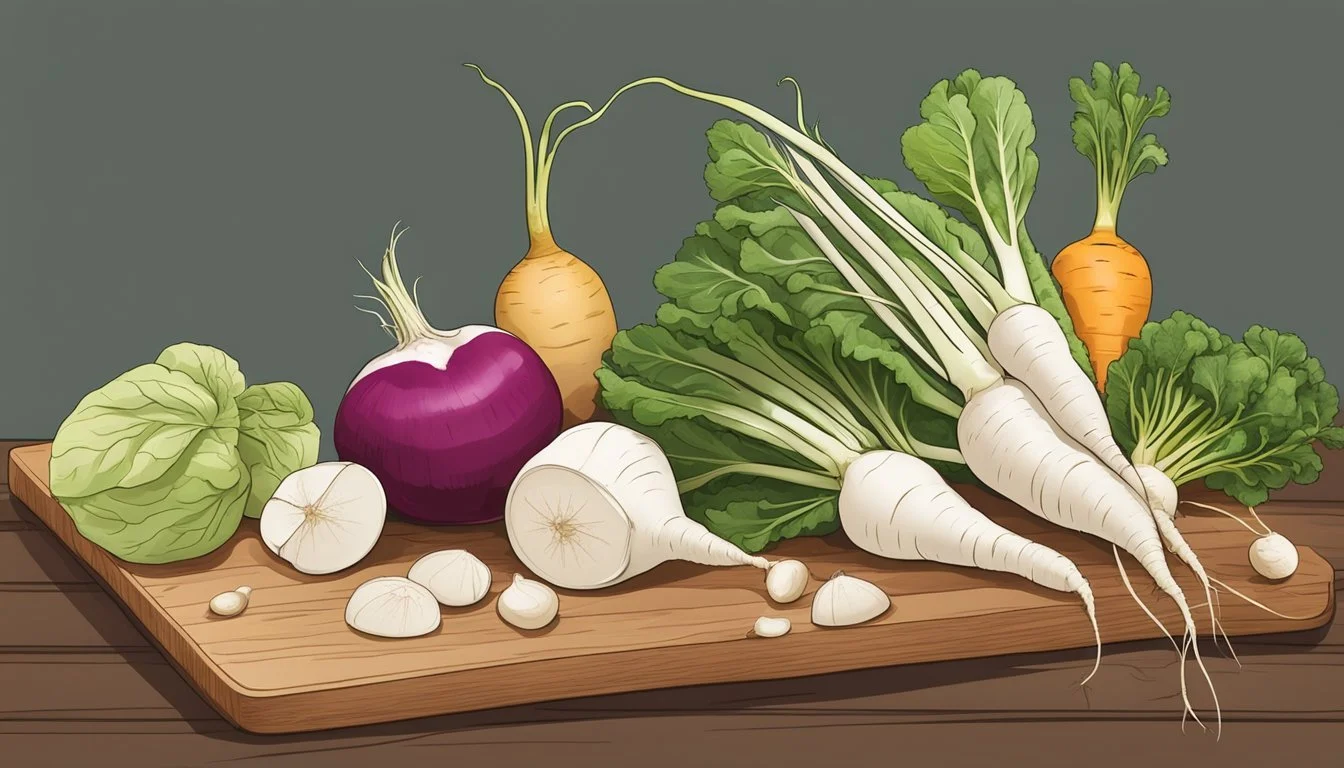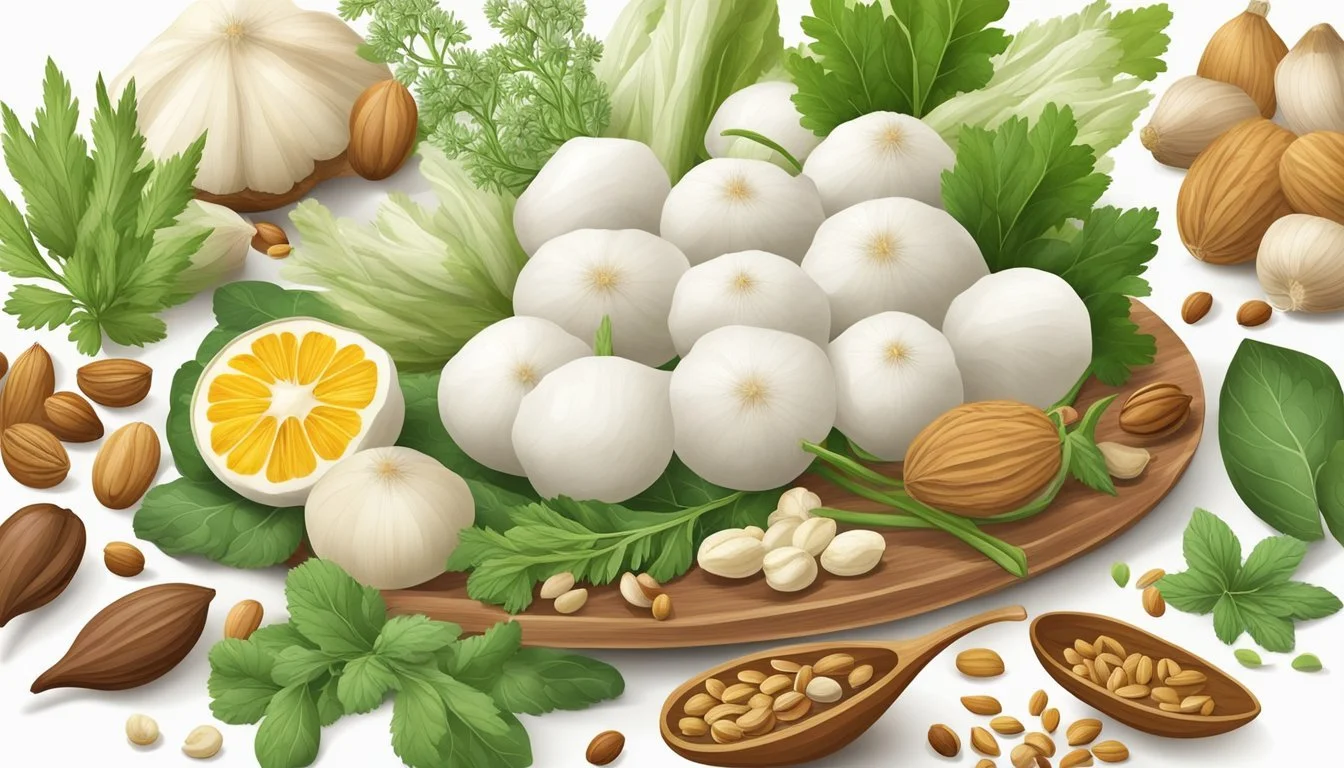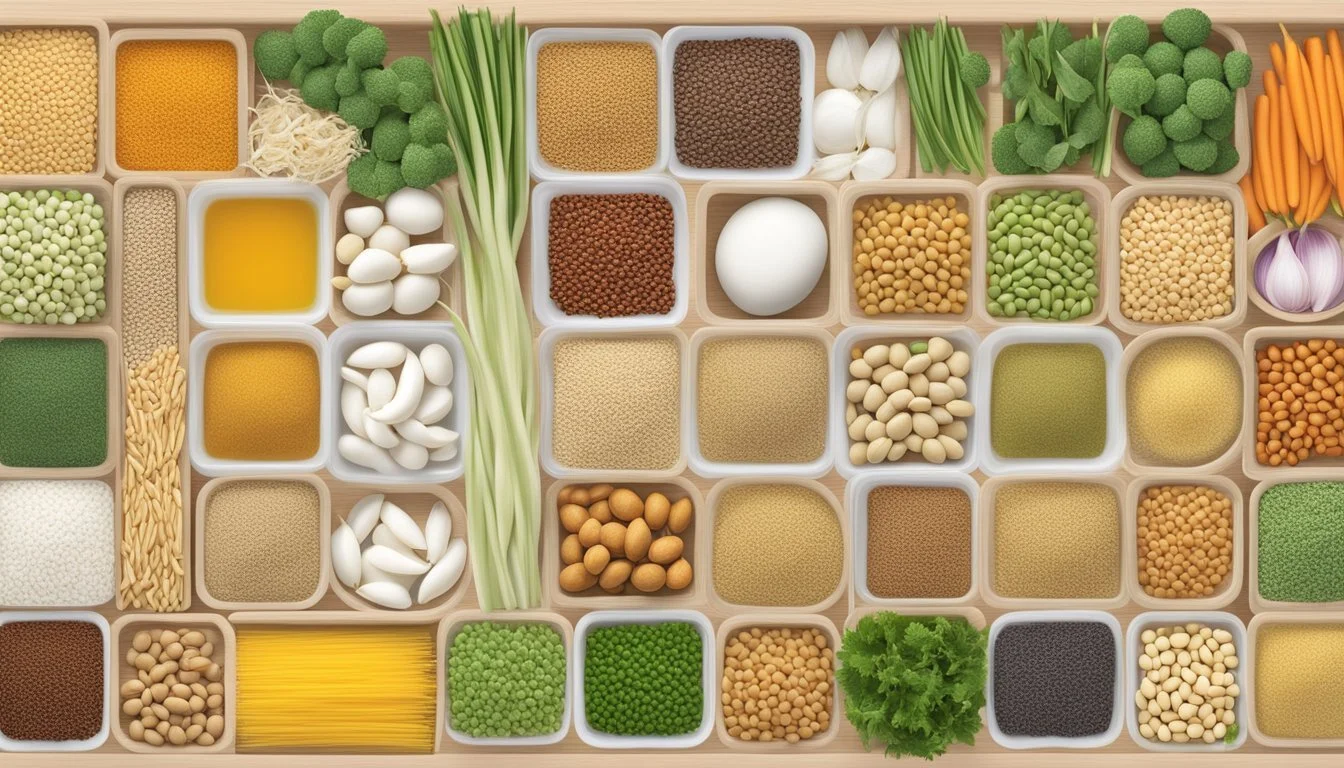White Radish Substitutes
Best Alternatives for Crispiness
White radish is a versatile ingredient often used in various culinary dishes for its crisp texture and mild flavor. But what happens when you can't find this key ingredient in your local store or need a quick substitution? Fortunately, there are several substitutes that can mimic the flavor and texture of white radish.
Horseradish, for example, can be a fantastic substitute if mixed with salt and vinegar to achieve a similar taste profile. Similarly, parsnips offer a comparable texture and can be used in both raw and cooked dishes, from salads to soups. White turnips also make a great alternative, providing a crunch and mildly sweet taste akin to white radish.
Exploring these substitutes not only can save your recipe but may also introduce you to new flavors and textures. Whether it's the spicy kick of horseradish or the subtle sweetness of jicama, these alternatives keep your dishes just as delicious and exciting.
Understanding
White radish, most commonly known as daikon, is a staple in many Asian cuisines. It has a mild, peppery taste and provides various health benefits, making it a versatile ingredient in cooking.
Culinary Uses and Flavor Profile
White radishes have a peppery taste that adds a distinctive flavor to dishes. In Asian cuisine, they are often used in salads, soups, and stews. They are a key ingredient in kimchi, a popular Korean dish.
Raw white radishes add a crisp, refreshing crunch to salads and slaws. When cooked, they soften and absorb the flavors of the other ingredients, making them ideal for stews and braises.
Nutritional Benefits
White radishes are low in calories but rich in fiber, which aids in digestion and promotes weight loss. They are an excellent source of vitamin C and folate, essential for maintaining a healthy immune system and cell growth.
Their antioxidant properties help combat free radicals, potentially reducing the risk of chronic diseases. Including them in your diet can contribute to overall health, particularly concerning digestion and immune support.
Common Varieties
The daikon radish, also known as Japanese radish, is the most prevalent variety of white radish. It is typically large and can grow up to 20 inches in length.
Other notable varieties include the Chinese radish, winter radish, and watermelon radish, which has a green exterior and a vibrant pink interior. Each variety features subtle differences in taste and texture, but all share the characteristic peppery taste.
Adding these radishes to your diet can enhance both the flavor and health benefits of your meals.
Selecting Radish Substitutes
When looking for a substitute for white radish, it's important to consider both the flavor and texture required by the dish. Different substitutes perform better in certain types of dishes, such as soups, stews, or raw salads.
Criteria for Choosing Alternatives
The primary factors to consider include texture and flavor. A radish substitute should ideally have a similar crunch when used raw or maintain a good consistency when cooked.
Texture: Choose an alternative that matches the crispness or softness, depending on the dish. For raw dishes, a crunchy vegetable like jicama works well.
Flavor: Selecting a root vegetable with a comparable flavor profile is crucial. For instance, horseradish offers a similar spice level but is much stronger, thus requiring careful use.
Preparation Method: Consider how the substitute holds up when cooked. Turnips, for instance, are great in stews and casseroles.
Nutritional Content: Ensure the substitute adds similar health benefits, such as vitamins and minerals.
Best Substitutes for Specific Dishes
Here are some ideal substitutes based on the dish type:
Raw Salads and Salsas: Jicama offers a sweet, nutty flavor and crisp texture suitable for salads.
Soups and Stews: Turnips and parsnips both provide a robust flavor and soften nicely when cooked, making them excellent for hearty dishes.
Pickled Dishes: Daikon radish can replace white radishes effectively for pickling, maintaining the crunch and absorbing pickling flavors well.
Roasted and Baked: Parsnips and turnips roast well, developing a sweet and earthy flavor when cooked.
Sautéed and Steamed: Korean radish can be a good option for these cooking methods due to its dense texture and mild flavor.
Each of these substitutes brings unique qualities to dishes and works well depending on how the white radish is intended to be used.
Root Vegetable Substitutes
When looking for substitutes for white radish, root vegetables like turnips, rutabaga, carrots, parsnips, jicama, celeriac, beets, and kohlrabi offer diverse flavors and textures that can complement various dishes. These alternatives provide different levels of sweetness, pepperiness, and earthiness that can enhance soups, salads, and roasted dishes.
Turnips and Rutabaga
Turnips and rutabaga are excellent substitutes for white radish. Turnips possess a slightly mild peppery flavor that can mimic the taste of radishes. They're versatile and can be used in salads, stews, and roasted dishes. Rutabaga, which is often confused with turnip, has a sweeter, earthier flavor, offering a unique twist to recipes where white radish would typically be used. Both root vegetables can be roasted, boiled, or mashed, making them adaptable to a variety of culinary applications.
Carrots and Parsnips
Carrots and parsnips are popular root vegetables that can serve as white radish substitutes. Carrots have a natural sweetness that becomes more pronounced when cooked. They are ideal for soups, salads, and roasted preparations. Parsnips, on the other hand, are slightly spicier and nuttier, complementing dishes that require a heartier flavor. Parsnips can be roasted, fried, boiled, or baked, making them a versatile replacement for white radish in many recipes. Both can be used raw in salads but shine the most when cooked.
Jicama and Celeriac
Jicama and celeriac are less common but equally useful substitutes. Jicama, known for its crisp texture and mild, sweet, nutty flavor, can replace white radish in salads and raw dishes. It brings a refreshing crunch that's perfect for light, fresh dishes. Celeriac, or celery root, has a more pronounced celery flavor with a savory note, making it an excellent addition to soups and stews. Its unique taste and texture can provide a distinctive character to dishes where white radish's mildness is desired.
Beets and Kohlrabi
Beets and kohlrabi offer distinct flavors and textures that can substitute for white radish. Beetroots have an earthy, slightly sweet flavor and tender texture that can enhance both roasted dishes and salads. They bring a vibrant color and a depth of flavor to various preparations. Kohlrabi, with its crisp texture and mildly peppery flavor, can serve as a crunchy substitute in salads and slaws. It can also be used in soups and roasted dishes, providing a slightly bitter taste that balances the sweetness of other ingredients.
Each of these root vegetables brings unique characteristics to the table, allowing for creative flexibility in replacing white radish in a multitude of recipes.
Other Vegetables and Fruits as Substitutes
When a white radish substitute is needed, several other vegetables and fruits can come in handy. These alternatives can offer similar textures, flavors, or even enhance the dish's taste in unique ways. Below are some options that can effectively replace white radishes.
Cabbage Family Alternatives
Cabbage and Napa cabbage are excellent substitutes for white radishes. Napa cabbage mimics the crunch and mildness of a white radish, making it ideal for salads and stir-fries.
Kohlrabi, a lesser-known member of the cabbage family, also works well due to its sweet, mild flavor and crispy texture. Using shredded Napa cabbage or sliced kohlrabi can maintain the desired bite in a dish.
Apples and Pears for Sweetness
For a hint of sweetness, apples and pears are suitable substitutes. Their crisp texture and natural sugars enhance salad and slaw recipes.
While apples are firmer and slightly tangy, pears offer a smoother texture and a more subtle sweetness. Both fruits work well in raw form, balancing the flavors of more savory ingredients.
Cucumbers and Bell Peppers
Cucumbers and bell peppers bring a refreshing quality to dishes traditionally featuring white radishes. Cucumbers are especially good for raw applications like salads and pickling due to their high water content and mild flavor.
Bell peppers, particularly the green and red varieties, add a crunchy texture and a touch of sweetness. They can be sliced thinly and used in salads or as a garnish, complementing both the flavor and appearance of the dish.
Herbs, Nuts, and Seeds
Using herbs, nuts, and seeds can add a unique twist to dishes that typically call for white radish. Common replacements like fennel, celery, horseradish, and mustard seeds offer distinct flavors and textures.
Fennel and Celery
Fennel and celery are excellent substitutes for white radish due to their unique flavor profiles and crunchy textures.
Fennel, with its subtle anise flavor, can be thinly sliced for salads or roasted for a sweet, caramelized finish. Its crisp texture makes it a suitable alternative in dishes where white radish is used for crunch.
Celery brings a milder taste with a slight peppery hint. It can be chopped or sliced for soups, stews, and salads, providing both crunch and freshness. In addition to being versatile, both vegetables are readily available and easy to prepare.
Horseradish and Mustard Seeds
Horseradish and mustard seeds are ideal for those seeking a spicy kick similar to what white radish offers.
Horseradish root, known for its intense heat, can be grated and added to sauces, dressings, or even pickled for a long-lasting condiment. Its pungent flavor mirrors the sharp bite of white radish, making it perfect for dishes that require bold flavors.
Mustard seeds can be ground into a powder or used whole to impart a peppery heat. When incorporated into pickled daikon recipes or added to vegetable mixes, they provide a robust, spicy note. The versatility and strength they bring make them staples in many kitchens.
Legume-Based Substitutes
One legume-based substitute for white radish is water chestnuts. These substitutes provide a similar crunchy texture and are frequently used in various Asian cuisines and salads.
Using Water Chestnuts
Water chestnuts offer a distinctive crunch that makes them a suitable replacement for white radish in many dishes.
These aquatic vegetables are staples in Asian cuisines due to their crispy texture and subtle flavor. They can be sliced or diced and added to salads, stir-fries, and other dishes where a firm texture is desired.
When using water chestnuts as a substitute, be mindful of their slightly sweet taste, which differs from the mild peppery flavor of white radish. This difference can enhance the flavor profile of salads, making them a versatile replacement.
Special Dietary Considerations
White radish substitutes can cater to a variety of dietary needs. Here are the options that specifically address vegan and gluten-free requirements.
Vegan and Gluten-Free Options
For those following a vegan or gluten-free diet, several white radish substitutes are suitable. Jicama is a versatile option. It has a crunchy texture similar to radishes and a mildly sweet, nutty flavor. It works well in salads and slaws.
Kohlrabi is another excellent choice. It offers a slightly sweeter taste than radishes and maintains a crisp texture. Both of these vegetables can be used in a 1:1 ratio as radish substitutes.
When looking for gluten-free choices, ensure that any packaged alternatives do not contain gluten-containing additives. Fresh, whole vegetables like jicama and kohlrabi are naturally gluten-free and can be confidently used without concern for added gluten.
Incorporating White Radish Substitutes in Cooking
When cooking, creativity with vegetable substitutes can enhance a dish's texture and flavor. Red radishes bring a robust flavor that pairs well with butter, cream-based sauces, and lemon. Their peppery bite can be balanced by slicing them thinner.
Horseradish, known for its pungent odor and spicy kick, is another strong option. It works well in sauces and soups where a strong flavor is desired.
For a crunchier texture, jicama fits the bill. With its sweet, nutty profile, it can replace white radish in salads at a 1:1 ratio.
Kohlrabi offers a slightly sweeter taste, making it suitable for both raw and cooked dishes. It adds a delightful texture to slaws and stir-fries.
Parsnips are another alternative, providing a texture similar to white radish, especially when roasted, fried, or baked. They can also be used raw in salads for a milder flavor.
Water chestnuts are notable for their fresh crispness and are best used raw. They can be an excellent substitute in Asian dishes like stir-fries or fresh salads.
Here’s a quick guide:
Substitute Best Used In Notes Red Radishes Salads, Soups, Cream Sauces Robust flavor, slice thinner Horseradish Sauces, Soups Strong, spicy flavor Jicama Salads Sweet, nutty flavor, 1:1 ratio Kohlrabi Raw dishes, Stir-fries Slightly sweeter taste Parsnips Roasted, Baked, Salads Mild flavor Water Chestnuts Salads, Stir-fries Fresh and crisp
Incorporate these substitutes to add variety and creativity to your cooking, tailoring each dish to meet your desired texture and flavor profile.








